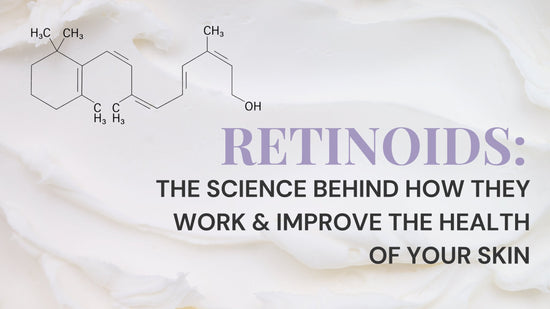What Are Retinoids Used in Skin Care Products?
Retinoids are a type of Vitamin A used to treat acne, wrinkles, psoriasis, and hyperpigmentation. Retinoid creams have a lot of evidence-based research to support their use which is why there are so many prescription retinoids.1 I am a dermatologist in Miami and I prescribe retinoids for at least 80% of my patients. This blog will tell you why I feel they are so good to treat many skin issues. This basic guide to retinoids in topical skin care will compare the various types of retinoids like retinol, adapalene, tretinoin, tazarotene, and trifarotene.
If you are trying to find retinoid containing skincare products that are right for your skin type, make sure you know your Baumann Skin Type. Once you know your skin type, we can give you more specific advice on which retinoids to use.
What are retinoids?
The definition of a retinoid is a natural or laboratory-made ingredient in the Vitamin A family that binds the retinoic acid receptor (RAR). When the RAR receptor is bound and turned on (like a key in a lock), many important genes are affected that turn on and off cellular pathways.

Types of Retinoids
There are many types of retinoids used topically in skincare including:
- Adapalene
- Tazarotene
- Tretinoin
- Trifarotene
- Retinaldehyde (Retinal)
- Retinol
- Retinyl Esters
These are the retinoids that you can get without a prescription:
- Adapalene (Both RX and OTC)
- Retinaldehyde (Retinal)
- Retinol
- Retinyl Esters
List of Retinoids

There are 3 generations of retinoids. The second and third generation retinoids area all prescription only. The topical retinoid ingredients found in prescription skin care include tretinoin, adapalene, tazarotene, and trifarotene. Adapalene is both an OTC and a prescription drug. Cosmetic retinoids include retinol, retinoid esters such as retinyl palmitate and retinyl linoleate, and retinal (also called retinaldehyde). The retinyl esters such as retinyl palmitate2 and retinyl lineolate do not penetrate into the skin very well, Beta Carotene is also a retinoid.
Chemical Structure of Retinoids
The chemical structure of retinoids36 is shown below. Click here to learn more about the science of retinoids and how retinoids improve aged skin and acne.

Conversion into Retinoic Acid
Retinol and retinyl palmitate are precursors to all-trans retinoic acid (ATRA), the active form that binds the RARs and exerts therapeutic effects on the skin. When applied to skin, these compounds undergo enzymatic conversion within the skin to become retinoic acid. The conversion process involves specific enzymes.
Once converted to retinoic acid (RA) in the skin, RA binds to retinoic acid receptors and exert its effects such as promoting collagen production. It's important to note that this conversion process can result in a delayed onset of effects compared to direct application of retinoic acid.

Conversion of Retinyl Esters
Retinyl palmitate, retinyl linoleate and other esterified forms of vitamin A are converted to retinol in the skin by esterases.
Conversion of Retinol
Retinol is oxidized to retinaldehyde by alcohol dehydrogenases. In the final step, retinaldehyde is converted to retinoic acid through the action of aldehyde dehydrogenases.
Conversion of Retinaldehyde
Retinaldehyde is converted into retinoic acid through the action of a group of enzymes called aldehyde dehydrogenases.
Light Sensitivity of Retinoids
Retinoids vary in their sensitivity to light. First-generation retinoids, such as tretinoin and retinol, are known to be sensitive to light, which can lead to their breakdown and a decrease in efficacy when exposed to sunlight. Retinaldehyde, another first-generation retinoid, also shows some sensitivity to light, though to a lesser extent compared to tretinoin and retinol. Retinyl esters, used in many cosmetic formulations, are more stable than retinol but still can degrade with light exposure. In contrast, second-generation retinoids like adapalene and third-generation retinoids such as tazarotene and trifarotene exhibit greater stability in the presence of light, making them suitable for daytime use. Therefore, while tretinoin, retinol, and retinaldehyde are best applied at night to avoid light-induced degradation, adapalene, tazarotene, and trifarotene can be incorporated into both day and night skincare routines.
This list compares sensitivity to light of the various topical retinoids:
- Tretinoin (most sensitive to light)
- Retinol
- Retinaldehyde
- Retinyl Esters
- Adapalene
- Tazarotene
- Trifarotene (least sensitive to light)

Can I use retinol and tretinoin together?
Tretinoin is retinoic acid and retinol turns into retinoic acid in the skin. They are the same thing except tretinoin is stronger. Using these together can cause over exfoliation. However, if tretinoin is too strong for you, you can try using tretinoin one day and then a low strength retinol for 3 days and then tretinoin again on day 5. As you adjust, you can slowly increase how often you use tretinoin with the goal of using tretinoin every night and stopping the retinol.
Which Retinoid To Use First?
When you are a beginner to retinoids, it is best to start with a weaker retinoid like a low strength and work your way up. Begin with retinol, then use adapalene and then switch to tretinoin. Once you can handle tretinoin, switch to tazarotene.
If you want to use a prescription medication and you are choosing between adapalene and tretinoin - start with adapalene.
Plant-Derived, Natural and Organic Retinoids
There are no organic or natural alternatives to retinol and retinoids on the market at this time that are effective on the skin when used topically. Vitamin A, retinyl palmitate, retinol and beta carotene are retinoids found in the diet. These cannot be placed on the skin, nor can Vitamin A rich foods like carrots, because they will not penetrate into the skin to where the RAR are. So don’t waste your money on skin care products with carrot and other Vitamin A rich foods when you are wanting natural antiaging skincare. For retinoids in skincare to be effective- they must be made in the laboratory.
Carotenoids are plant derived retinoids and include alpha-carotene, beta-carotene, beta cryptoxanthin, lutein, zeaxanthin and lycopene. Plant derived retinoids are not very effective in topical skincare products because they do not penetrate very well into the skin. These natural plant derived retinoids are best to get in your diet. This is why you do not see vegan skin care products with retinoids. Homemade retinol serums will not work because putting carrots and other carotenoids on the skin is not beneficial because the Vitamin A is not in a form that it can get into the skin.
Bakuchiol and Retinoids
Bakuchiol, a natural ingredient that many claim is a natural form of retinoid, does NOT bind the RAR receptor and therefore by definition is not a retinoid.3 Bakuchiol has been shown to have antiaging effects similar to those seen with retinoids.
What Retinoids Do for Skin
Retinoids do many things to skin. The mechanism of action of their effects depends upon what skin conditions are being treated with retinoids. Below I discuss how retinoids work for different skin concerns. To learn more in depth science about retinoids read about RAR receptors or the Science of Retinoids.
Retinoids for Acne
Retinoids were first used orally for acne with a drug called Accutane (isotretinoin). Soon after, topical forms called tretinoin were developed. Later more stable second and third generation retinoids like adapalene4 and tazarotene5 6 were developed that do not break down when combined with benzoyl peroxide. This led to the development of several acne prescription drugs that combine adapalene or tretinoin with benzoyl peroxide and/or topical antibiotics7 in prescription acne medications. The newest prescription retinoid for acne is trifarotene8 which selectively binds the RAR gamma receptor.
Why Retinoids are Used To Treat Acne
Retinoid have the ability to regulate skin cell growth, reduce inflammation, and alter gene expression. They also target Toll-like receptor 2 (TLR-2), which is activated by acne-causing bacteria, leading to inflammation. By inhibiting TLR-2 activity, retinoids decrease the bacterial-induced inflammation, helping to clear acne. This mechanism, combined with their ability to enhance skin renewal and reduce clogged pores, makes retinoids effective in managing acne and improving skin health.
Retinoids for Wrinkles
Retinoids are the most effective and most proven skincare ingredients to improve wrinkles and sun damage (photodamage)10 11 12 because they have the most evidence-based data. In fact, tazarotene and tretinoin are FDA approved to improve photoaged skin.14 15 All retinoids that can penetrate into the skin should improve wrinkles, but only tretinoin, tazarotene and retinol16 have clinical studies proving that they treat wrinkles.17 Retinol is a cosmeceutical and is not FDA approved to treat wrinkles.
Retinoids are a must for anyone wanting to preserve the looks of their skin and to improve the appearance of the skin. Retinol is the only retinoid with good efficacy data18 19 that is available without a prescription.20 21 22 Retinyl palmitate, retinyl linoleate, retinaldehyde (retinal) do not penetrate well into the skin which lowers their efficacy.23
History of Retinoid Use in Wrinkles
Retinoids were used for acne before they were used for wrinkles. During the clinical trials for acne, investigators noticed that the skin looked smoother and younger when treated with tretinoin.9 This observation led to a plethora of research on retinoids to treat wrinkles on the face. Dr. Albert Kligman was one of the doctors who developed the use of retinoids for acne along with Dr. Jim Leyden and others.
This is a link to a podcast on YouTube where I interview Dr. Leyden about how this amazing discovery occurred that forever changed the way dermatologists treat skin aging.
How Retinoids Work on Wrinkles
Retinoids combat wrinkles by influencing gene expression, notably by activating genes that promote collagen production while inhibiting those involved in its breakdown, primarily through their impact on matrix metalloproteinases (MMPs) and collagenase. This action not only helps in preserving the skin's structure but also enhances the synthesis of vital components like hyaluronic acid and elastin. The overall effect is a significant reduction in wrinkles and an improvement in skin texture and firmness, showcasing retinoids' profound anti-aging capabilities.
How To Choose A Retinoid
The best way to find the right retinoid is to let us help you. Take the quiz and we can tell you which retinol to use. Once you get on the strongest retinol, you can progress to a stronger prescription retinoid.
Learn about Retinoids
You must use retinoids properly or you will have retinoid side effects.
Follow the links to learn more about each of these:
When To Use in Your Skincare Routine?
What do retinoids do for your skin?
How to use retinol cream for beginners
What step to use retinoid in skin care routine?
How to choose the best retinoid for beginners
Are there natural or organic retinoid creams?
How do retinoids work on wrinkles?
We can guide you on what retinoids are best for your Baumann Skin Type and how to use them.

Retinoid vs Retinol vs Retinyl Esters
Many people confuse the words retinol and retinoid. Retinol is in the retinoid family (which is also the Vitamin A family). All retinoids work like retinoic acid because they bind the retinoic acid receptor (RAR).
Retinyl palmitate, retinyl linoleate and any other ingredients with names resembling “Retinyl ____ate”, are chemically altered esters of retinol. While they are considered retinoids because they bind the RAR receptor, they penetrate very poorly into skin and are not very effective when used topically. Retinyl palmitate is controversial because it is believed to cause cancer when exposed to UV rays.24 (Avoid retinyl palmitate when you can or use it in conjunction with a sunscreen).
Other Names For Retinol?
There are many ineffective retinol products on the market. Retinol is the ingredient name to look for on the label- but many products that claim to have retinol actually have retinol-like ingredients that do not penetrate well into the skin like the retinyl esters: retinyl palmitate and retinyl propriate.25 This is a problem, but because retinol is considered a cosmetic ingredient, it does not have FDA oversight so quality control is compromised. Other names for retinoids are listed in the images above.
Which retinoid and retinol products are best?
All prescription retinoids undergo scrutiny from the FDA and can be trusted. They are manufactured properly and formulated with an FDA approved formulation.
Cosmeceutical retinoids are not regulated by the FDA and there are many ineffective ones on the market. Retinol breaks apart upon exposure to air or light and to oxidizing ingredients such as benzoyl peroxide. This means that the formulations, manufacturing, bottling and storage of retinol will affect its strength and efficacy. Also- the product labels of retinol products can be misleading. Many products that claim to have retinol on the label actually have retinyl esters such as retinyl palmitate.26 This is why you need to make sure you buy a retinol product from a source you trust.
What do retinoids do for skin?
Retinoids do many important things to the skin. To learn more about the science of how retinoids work, click here or read this reference.27
Here is a list of some of the benefits of retinoids like retinol on the skin:
- Increase the skin’s production of collagen, which helps smooth the appearance of fine lines and wrinkles
- Promote the skin’s natural exfoliation process to eliminate damaged surface cells
- Treat uneven skin tone by fading excess pigment and evening skin tone
- Prevent clogged pores and improve the appearance of pores
- Prevent and treat acne
- Improve red purple stretch marks28
- Speed wound healing29 when used prior to a surgical or laser procedure30
Retinoids are the best antiaging ingredient in antiwrinkle serums!
Will retinol improve crow's feet wrinkles?
Retinol has been shown to improve crow's feet wrinkles around the eyes when used for one year.
Two studies showed that using retinol 0.1% for 52-weeks (one year), 44% of subjects had a significant improvement of crow’s feet lines.(37-39) Combining retinoids with botulinum toxins like Botox in the crow’s feet area has been shown to improve crow’s feet better than Botox alone. (38) Retinol has also been shown to improve results of botulinum toxin injections. (39)
Using retinol and other retinoids has been shown to improve wrinkles, dark spots, acne, keratosis pilaris, skin texture and protect skin from further aging. It is worth the effort to use retinoids! Once you make it though the first 2-4 weeks you will get past the scaling and skin sensitivity and begin to see the befits. If you follow the skin care routine instructions for retinoids and use a skin care routine customized for your Baumann Skin Type, you should be able to begin using your retinoids without significant side effects.
Remember- only buy retinol products from a source you trust, there are many counterfeit products online and many products that do not contain what they claim or that are manufactured improperly. Here are some of our favorite retinols. You can also talk to your dermatologist about getting a prescription for tretinoin, adapalene or trifarotene or tazarotene.
Retinoid Side Effects
If you do not use your retinoids properly as described in this blog, then you can experience many retinoid side effects discussed in this blog. Retinoids are safe to use but can cause temporary redness, skin stinging, and peeling.
Long Term Effects of Retinol and Retinoids
Retinoids have been shown to thicken the dermal layer of the skin making it stronger and less likely to tear or wrinkle. Skin is smoother with less wrinkles. Skin pigmentation is more even. These benefits have been shown in dozens of studies. The longer you use the retinoid, the more benefits you will have. However- it may take 4-8 months to begin seeing benefits depending upon your skin type, the type of retinoid you use, and how much you use. You will get the best results if you follow the instructions at this link on how to use retinoids.
How Long Do Retinoid Benefits Last?
How long retinoid benefits last depends upon the type of retinoid used and how long the retinoid was used. We recommend not stopping retinoids and staying on them until something better is invented.
The beneficial long-term effects of retinoids seem to last for many months to years after stopping the retinoid.31 32 It is best to continue the retinoid nightly forever (or until something better is invented). However, if you forget to use your retinoids every once in a while, do not worry- you still get a good benefit from the retinoid. One study showed that after using tretinoin 0.05% cream nightly for 48 weeks, decreasing application to 3 times a week was able to sustain the skin benefits.33 Once a week of retinoid use also had a benefit, but not as much as 3 times a week. Therefore- you should use the retinoid at least 3 times a week to maintain the benefit after you have finished a 48-week course of every night. Many studies that examined skin under the microscope have shown beneficial long-term effects of retinoids such as increased collagen and hyaluronic acid levels in skin.34 35
There is so much to know about retinoids- but don’t worry- we can help you find the best retinoid for your Baumann Skin Type.

Does retinol exfoliate skin?
Yes retinoids are exfoliants. The stronger the retinol is the more exfoliating abilities it has.
Which retinoid is best for skin?
There are many things to consider when choosing a retinoid. You need to consider:
- Your Baumann Skin Type®.
- What other products are in your skin care routine
- When you are using the retinoid
- What strength of retinoid you should use.
Best References on Retinoids:
- Kang, S., & Voorhees, J. J. (1998). Photoaging therapy with topical tretinoin: an evidence-based analysis. Journal of the American Academy of Dermatology, 39(2), S55-S61.
- Duell, E. A., Kang, S., & Voorhess, J. J. (1997). Unoccluded retinol penetrates human skin in vivo more effectively than unoccluded retinyl palmitate or retinoic acid. Journal of investigative dermatology, 109(3), 301-305.
- Chaudhuri, R. K., & Bojanowski, K. (2014). Bakuchiol: a retinol?like functional compound revealed by gene expression profiling and clinically proven to have anti?aging effects. International journal of cosmetic science, 36(3), 221-230.
- Millikan, L. E. (2001). Pivotal clinical trials of adapalene in the treatment of acne. Journal of the European Academy of Dermatology and Venereology, 15, 19-22.
- Shalita, A. R., Chalker, D. K., Griffith, R. F., Herbert, A. A., Hickman, J. G., Maloney, J. M., ... & Sefton, J. (1999). Tazarotene gel is safe and effective in the treatment of acne vulgaris: a multicenter, double-blind, vehicle-controlled study. Cutis, 63(6), 349-354.
- Kakita, L. (2000). Tazarotene versus tretinoin or adapalene in the treatment of acne vulgaris. Journal of the American Academy of Dermatology, 43(2), S51-S54.
- Ochsendorf, F. (2015). Clindamycin phosphate 1.2%/tretinoin 0.025%: a novel fixed?dose combination treatment for acne vulgaris. Journal of the European Academy of Dermatology and Venereology, 29, 8-13.
- Tan, J., Thiboutot, D., Popp, G., Gooderham, M., Lynde, C., Del Rosso, J., ... & Gold, L. S. (2019). Randomized phase 3 evaluation of trifarotene 50 μg/g cream treatment of moderate facial and truncal acne. Journal of the American Academy of Dermatology, 80(6), 1691-1699.
- Looking Back on Retinoid Discovery and Development with Dr. James Leyden. Podcast on Spotify https://open.spotify.com/episode/6sX8GgIhVYtWm50dyDsYIt
- Singh, M., & Griffiths, C. E. (2006). The use of retinoids in the treatment of photoaging. Dermatologic therapy, 19(5), 297-305.
- Baumann L Ch 45 Retinoids in Baumann’s Cosmetic dermatology. 3rd edition (McGraw Hill 2022) in press
- Fisher, G. J., Talwar, H. S., Lin, J., & Voorhees, J. J. (1999). Molecular mechanisms of photoaging in human skin in vivo and their prevention by all?trans retinoic acid. Photochemistry and photobiology, 69(2), 154-157.
- Weinstein, G. D., Nigra, T. P., Pochi, P. E., Savin, R. C., Allan, A., Benik, K., ... & Thorne, E. G. (1991). Topical tretinoin for treatment of photodamaged skin: a multicenter study. Archives of dermatology, 127(5), 659-665.
- Kang, S., Krueger, G. G., Tanghetti, E. A., Lew-Kaya, D., Sefton, J., Walker, P. S., ... & Tazarotene Cream in Photodamage Study Group. (2005). A multicenter, randomized, double-blind trial of tazarotene 0.1% cream in the treatment of photodamage. Journal of the American Academy of Dermatology, 52(2), 268-274.
- Olsen, E. A., Katz, H. I., Levine, N., Shupack, J., Billys, M. M., Prawer, S., ... & Thome, E. G. (1992). Tretinoin emollient cream: a new therapy for photodamaged skin. Journal of the American Academy of Dermatology, 26(2), 215-224.
- Kong, R., Cui, Y., Fisher, G. J., Wang, X., Chen, Y., Schneider, L. M., & Majmudar, G. (2016). A comparative study of the effects of retinol and retinoic acid on histological, molecular, and clinical properties of human skin. Journal of cosmetic dermatology, 15(1), 49-57.
- Mukherjee, S., Date, A., Patravale, V., Korting, H. C., Roeder, A., & Weindl, G. (2006). Retinoids in the treatment of skin aging: an overview of clinical efficacy and safety. Clinical interventions in aging, 1(4), 327.
- Kafi, R., Kwak, H. S. R., Schumacher, W. E., Cho, S., Hanft, V. N., Hamilton, T. A., ... & Kang, S. (2007). Improvement of naturally aged skin with vitamin A (retinol). Archives of dermatology, 143(5), 606-612.
- Bellemere, G., Stamatas, G. N., Bruere, V., Bertin, C., Issachar, N., & Oddos, T. (2009). Antiaging action of retinol: from molecular to clinical. Skin pharmacology and physiology, 22(4), 200-209.
- Kang, S., Duell, E. A., Fisher, G. J., Datta, S. C., Wang, Z. Q., Reddy, A. P., ... & Voorhees, J. J. (1995). Application of retinol to human skin in vivo induces epidermal hyperplasia and cellular retinoid binding proteins characteristic of retinoic acid but without measurable retinoic acid levels or irritation. Journal of Investigative Dermatology, 105(4), 549-556.
- Li, W. H., Wong, H. K., Serrano, J., Randhawa, M., Kaur, S., Southall, M. D., & Parsa, R. (2017). Topical stabilized retinol treatment induces the expression of HAS genes and HA production in human skin in vitro and in vivo. Archives of dermatological research, 309(4), 275.
- Varani, J., Fisher, G. J., Kang, S., & Voorhees, J. J. (1998, August). Molecular mechanisms of intrinsic skin aging and retinoid-induced repair and reversal. In Journal of Investigative Dermatology Symposium Proceedings (Vol. 3, No. 1, pp. 57-60). Elsevier.
- Duell, E. A., Kang, S., & Voorhess, J. J. (1997). Unoccluded retinol penetrates human skin in vivo more effectively than unoccluded retinyl palmitate or retinoic acid. Journal of investigative dermatology, 109(3), 301-305.
- https://www.mdedge.com/dermatology/article/57245/melanoma/retinyl-palmitate/page/0/1
- Temova Rakuša, ., Škufca, P., Kristl, A., & Roškar, R. (2021). Quality control of retinoids in commercial cosmetic products. Journal of Cosmetic Dermatology, 20(4), 1166-1175.
- Temova Rakuša, ., Škufca, P., Kristl, A., & Roškar, R. (2021). Quality control of retinoids in commercial cosmetic products. Journal of Cosmetic Dermatology, 20(4), 1166-1175.
- Imhof, L., & Leuthard, D. (2021). Topical Over-the-Counter Antiaging Agents: An Update and Systematic Review. Dermatology, 237(2), 217-229.
- Elson, M. L. (1990). Treatment of striae distensae with topical tretinoin. The Journal of dermatologic surgery and oncology, 16(3), 267-270.
- de Campos Peseto, D., Carmona, E. V., Silva, K. C. D., Guedes, F. R. V., Hummel Filho, F., Martinez, N. P., ... & Priolli, D. G. (2016). Effects of tretinoin on wound healing in aged skin. Wound Repair and Regeneration, 24(2), 411-417.
- Orringer, J. S., Kang, S., Johnson, T. M., Karimipour, D. J., Hamilton, T., Hammerberg, C., ... & Fisher, G. J. (2004). Tretinoin treatment before carbon-dioxide laser resurfacing: a clinical and biochemical analysis. Journal of the American Academy of Dermatology, 51(6), 940-946.
- Ellis, C. N., Weiss, J. S., Hamilton, T. A., Headington, J. T., Zelickson, A. S., & Voorhees, J. J. (1990). Sustained improvement with prolonged topical tretinoin (retinoic acid) for photoaged skin. Journal of the American Academy of Dermatology, 23(4), 629-637.
- Singh, M., & Griffiths, C. E. (2006). The use of retinoids in the treatment of photoaging. Dermatologic therapy, 19(5), 297-305.
- Olsen, E. A., Katz, H. I., Levine, N., Nigra, T. P., Pochi, P. E., Savin, R. C., ... & Jou, H. C. (1997). Sustained improvement in photodamaged skin with reduced tretinoin emollient cream treatment regimen: Effect of once-weekly and three-times-weekly applications. Journal of the American Academy of Dermatology, 37(2), 227-230.
- Bhawan MD, J. (1998). Short?and long?term histologic effects of topical tretinoin on photodamaged skin. International journal of dermatology, 37(4), 286-292.
- Bhawan, J., Olsen, E., Lufrano, L., Thorne, E. G., Schwab, B., & Gilchrest, B. A. (1996). Histologic evaluation of the long term effects of tretinoin on photodamaged skin. Journal of dermatological science, 11(3), 177-182.
- Baumann, L. Ch. 45 Retinoids in Baumann Cosmetic Dermatology Edition 3 (McGraw Hill 2022)
- Randhawa M, Rossetti D, Leyden JJ, Fantasia J, Zeichner J, Cula GO, et al. One-year topical stabilized retinol treatment improves photodamaged skin in a double-blind, vehicle-controlled trial. J Drugs Dermatol. 2015;14(3):271-80.
- Carcamo, A. S., Guiha, I., Goldman, M. P., Rao, J., & Ehrlich, M. (2008). The Safety and Efficacy of Botulinum Toxin Type A Plus Tazarotene 0.1% Cream in the Treatment of Lateral Canthal Rhytids: A Randomized, Double-Blind, Placebo-Controlled Study. The American Journal of Cosmetic Surgery, 25(2), 78-88.
- Ascher, B., Fanchon, C., Kanoun-Copy, L., Bouloc, A., & Benech, F. (2012). A skincare containing retinol adenosine and hyaluronic acid optimises the benefits from a type A botulinum toxin injection. Journal of Cosmetic and Laser Therapy, 14(5), 234-238.
- Antille, C., Tran, C., Sorg, O., & Saurat, J. H. (2004). Topical β‐carotene is converted to retinyl esters in human skin ex vivo and mouse skin in vivo. Experimental dermatology, 13(9), 558-561.

























































